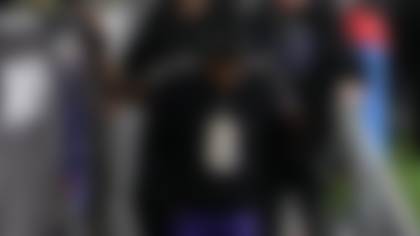It is obvious that finding the right quarterback is the key to success in the NFL. So, you're thinking to yourself: Find an expert. Find someone who knows. Someone with a track record. Over the past 25 years, no one has had a better track record than former Packers GM Ron Wolf: In his days building the Tampa Bay Buccaneers from the ground up, he pulled the trigger on Doug Williams. At Green Bay, he traded for Brett Favre, and also drafted Mark Brunell, Matt Hasselbeck and Aaron Rodgers. All of them developed, all of them not only met but exceeded expectations. He has an eye. If anyone knows quarterbacks, it's Ron Wolf.
And yes, he would have taken Peyton Manning over Ryan Leaf in 1998. But he also points out that virtually everyone who preferred Manning still would have taken Leaf second overall. And Wolf has no pretensions to being the Quarterback Soothsayer. "Never mind Manning vs. Leaf," he says. "I thought Heath Shuler was going to be a Pro Bowler." Shuler lasted four years in the NFL and was a sub 50% career passer.
Now one of the main reasons I'm calling games and working for NFL Network and not still coaching games for the Baltimore Ravens is that I was unable to develop a Pro Bowl quarterback during my nine years in Baltimore. It wasn't for lack of trying.
We knew going into the 2003 NFL Draft that we had to get a quarterback. We had gone through the normal progression of castoffs, and even won a Super Bowl with that. But going forward, we needed someone around whom we could build our team. With the 19th pick in the 2003 draft, we selected Kyle Boller of California. He excelled in a pro style offense, had a live arm and a good head on his shoulders.
Phil Savage, then our director of personnel, had been tracking Boller all year and got more and more excited about him as the year went on. The three main names coming out of that draft at quarterback were Carson Palmer from USC, Byron Leftwich from Marshall, and Boller. Each had all the credentials and were projected as early first-round picks.
It was interesting at the combine in that we just happened to have all three of these quarterback interviews back-to-back-to-back. Even though each interview lasted just 15 minutes, you got a clear picture of the differences in the quarterbacks' personalities by speaking with them consecutively. Each had excellent measurables, but as is usually the case, each had one little qualifier. Scouts and coaches alike always end up with a qualifier about even the best of players, so that if a player doesn't turn out as projected, they can say "Well, I did say he had…."
For these three, the qualifiers were very specific. With Palmer, people were worried about his leadership ability. He did not seem to have a lot of the personal charisma that you normally associate with a quarterback. Although he was a bright and intelligent young man, you came out of the interview not real fired up about him as a leader. Such was not the case with the next two. Leftwich and Boller had energy and leadership ability in spades. The concerns with Leftwich were his previous injuries and lack of mobility in the pocket. For Boller it was his accuracy.
Lombardi: Lessons from the master
When it came to the draft, Bill Walsh was a masterful scout. Michael Lombardi recalls lessons learned from an iconic coach. **More ...**
Like Bill Devaney and the Chargers group with Ryan Leaf, we convinced ourselves in each case that the minuses were not justified. With Palmer, we liked enough of the rest that we thought he could grow into the leadership role. With Leftwich we convinced ourselves that his mobility was no worse than a lot of NFL quarterbacks. With Boller, we decided that the lack of quality receivers at Cal was a significant part of the reason for his lack of accuracy.
Eventually, we were able to secure the New England Patriots' first-round pick, the 19th overall, which we used to take Boller. Within a couple of years, we learned that Boller's inaccuracy was not solely a result of the poor receivers at Cal, but also Kyle's occasional nervousness in the pocket, which forced his fundamentals to falter at critical times, and has left him a sub-60 percent completion guy thus far in his career.
So it didn't work out for Boller, or for me. I left after the 2007 season. The Ravens still needed a quarterback heading into the 2008 draft. So Ozzie and the personnel department worked diligently to scout the next round of athletes. They worked out Matt Ryan and Brian Brohm and Chad Henne. They also took a day and worked out Joe Flacco, a strong-armed kid who had started at Pittsburgh and then transferred to Division I-AA power Delaware.
The process was the same, as were the people doing the evaluating, except that now Cam Cameron, the new offensive coordinator and former head coach of the Miami Dolphins, was involved. Cam had been fired as head coach in Miami after the 2007 season and was heavily criticized for taking quarterback John Beck from BYU with the 40th pick in the 2007 draft. The 50/50 rule remained in full effect. The Ravens went 50/50 on the picks of Boller then Flacco, while Cameron, as an individual, went 50/50 on the picks of Beck and Flacco. The result was that Flacco (who was, at first, not asked to win games, only to manage them) showed a cannon arm, good pocket presence, and a calm, unruffled demeanor, and quarterbacked the Ravens to two AFC title games.
There are a lot of teams sitting between picks five and 15 in the draft this year that will be looking at Ryan Tannehill of Texas A&M and asking themselves, in essence, whether he's another Flacco or another Boller. Inevitably, at least one of those quarterback-needy teams will talk itself into thinking Tannehill can be another Flacco.
Much of the material above has been adapted from the book, "More Than A Game: The Glorious Present and Uncertain Future of the NFL," written by Brian Billick and Michael MacCambridge. Follow Brian Billick on Twitter @coachbillick




